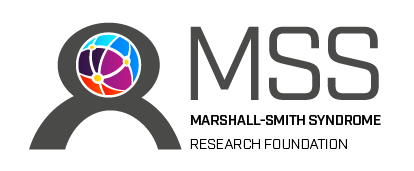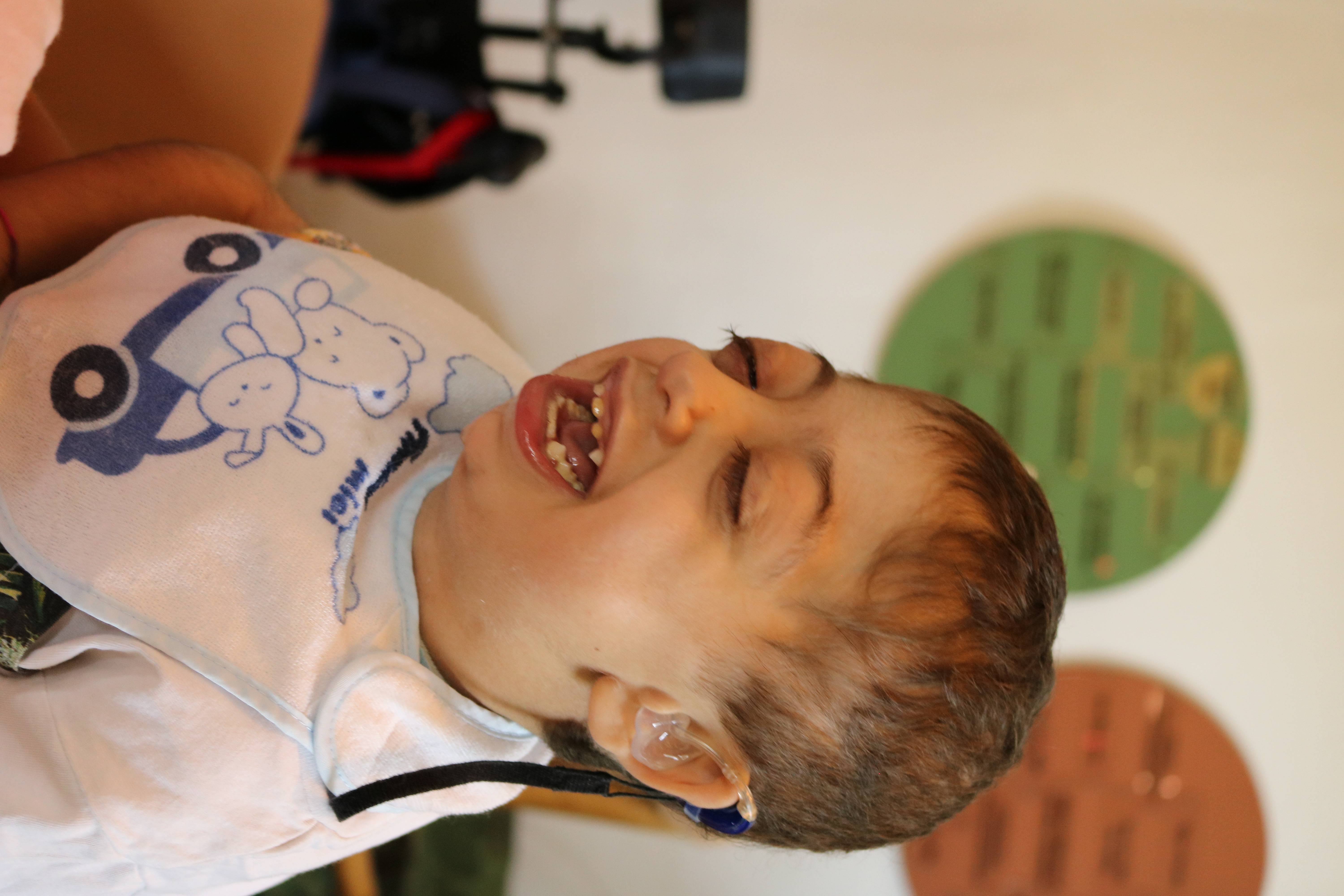The Marshall-Smith syndrome (MSS) is a very infrequently described syndrome. The syndrome has been described for the first time in 1971. Since then, about 50 children and adults with the syndrome are known in the medical literature worldwide.
The syndrome is characterized by:
- Abnormal bone formation, showing in accelerated bone formation in the hands and feet;
- Problems with growth and nutrition;
- Difficulty breathing;
- Mental and motor retardation;
- Unusual facial features as clearly visible forehead, shallow orbits, retracted chin, sunken nose bridge and bluish eye whites;
- Fractures that occur without obvious reason from the age of 5 years.
Description
Marshall-Smith syndrome (MSS) was first described in two males seen in 1971 by Drs. Marshall, Graham, Scott, and Smith. They noticed changes in the skeletal system of these patients. Bones normally mature through several stages, naturally progressing through these stages with time. Specifically, a young child's bones have more cartilage and less calcium deposits than an adult's bones. A child's bones appear less "dense" on an x ray than an adult's bones. A constant feature of MSS is skeletal maturation. At birth or in the first months of life, the bones of the wrist and feet look more developed that normal when studies with an X-ray are performed. Doctors usually describe this as an advanced bone age. X-rays of other bones however look mostly normal, without an advanced development, and only infrequently with a somewhat abnormal shape.
So in fact the bone age is not advanced but only the bone formation in the wrist and feet is abnormal. The abnormal shape of bones shows in a narrow upper part of the chest and in long and slender fingers and toes. The size of babies at birth is normal, but growth is reduced after this and older children and adults are significantly shorter and lighter than expected. The mean adult height is severely decreased compared to normal but difficult to determine with certainty due to the abnormal shape of the spine; usually final height is estimated to be 130-140cm. Growth of the head is not affected, and the head size remains normal throughout life.
Specific facial features in MSS include a wide and prominent forehead, protruding and widely spaced eyes, a very small chin, and a small, upturned nose. Because individuals may not gain weight or grow well, they are often smaller than other children of the same age. There are often problems with structures in the respiratory tract (such as the larynx and trachea) and this can lead to difficulty with breathing. Pneumonia, or a lung infection, is common because of this; these can occur several times.
Significant mental and physical delays are almost always occurring in MSS. They may also be slower to do physical things like crawling or walking.
No two patients with MSS have the exact same symptoms, as there is quite some variability with the condition. There are no alternate names for Marshall-Smith syndrome, though it is sometimes incorrectly referred to as Weaver syndrome, a separate condition with symptoms that resemble those of MSS.
Families with MSS can be put under a great deal of stress, because long-term hospitalizations in the intensive care unit are common for children with MSS.
Genetic profile
The vast majority of people with MSS are unique in their family; there is usually no family history of the condition. If standard genetic testing, such as chromosome analysis and metabolic studies, are performed MSS cannot be found: one should search for this specifically before one can find it. The gene for MSS has now been found and is called NFIX. Until now all children and adults in whom the diagnosis has been made in a reliable way have had a change in this gene. The change is only present in the child with MSS and not in one of the parents (in medical terms: spontaneous mutation). MSS is therefore an entity that typically starts in the child with MSS: the chance that this happens again is very small (although not zero). So if in a family a child is born with MSS and the diagnosis has been confirmed by Genetic studies, the chances for another child of the same parents to have MSS again are very small. The chances for healthy brothers and sisters of someone with MSS to get a child with MSS as well are the same as everyone else in the population. It is always good to ask for exact details for this to your local clinical geneticist who can explain this in detail.
Demographics
Marshall-Smith syndrome has been detected very infrequently in the general population. In fact, no statistical rates are available for the condition. It appears to be present across the world, affecting males and females equally.
Signs and symptoms
The most medically serious complication in MSS is the associated respiratory problems. Structures in the respiratory system, such as the larynx and trachea, may not function properly because they can be "floppy," soft, and less muscular than usual. Because of this, airways can become plugged or clogged, since air does not move through to clear them like usual. Mucus may start collecting, causing an increased amount of bacteria that can lead to pneumonia. Ear infections are common, because the bacteria can spread to the ears as well. Internal nasal passages may be narrower in people with MSS, which can also pose difficulty with breathing.
Children with MSS may have problems with eating, due to similar reasons that they may have difficulty breathing. Additionally, they may have a weak "suck" and "swallowing" reflex, normally controlled by muscular movements. As mentioned earlier, another feature of MSS is lack of proper growth and weight gain. This can be in part due to the difficulty in feeding for these individuals, though they are often very small even at birth.
Advanced bone age is present in all people with MSS. In particular, the bones of a newborn child with MSS appear more dense on an x ray than they should, according to their age. While x rays of their hands and wrists often determine a person's "bone age," people with MSS often have a generalized advanced bone age within their entire skeleton. They may also have broad middle phalanges of the hand, which can be seen on an x ray. Later on the bones are in fact much less dense than normal (“osteoporotic”) which gives rise to an increased chance to get fractures.
Facial characteristics of people with MSS include those mentioned earlier, but other features may also occasionally be present. These can be blue-tinged sclerae (the white sections of the eyes), a large head circumference (measurement around the head), and a small, triangle-shaped face (with the point of the triangle being at the chin).
Occasionally, creases in the hands are "deeper" than usual in people with MSS. The first ("big") toe can also be longer and bigger than usual. Additional features include hirsutism and an umbilical hernia. Hearing loss can sometimes occur. Ears may be larger, have a "crumpled" appearance, or be lower on the head than usual.
Changes in the brain can occur in MSS. An individual was reported in 1997 to have a smaller optic nerve (the nerve the connects the eyes to the brain) than usual, and had some vision problems as a result. Some children may be missing the corpus callosum, a structure in the brain. Mental and physical delays have always been present in MSS until now, and are usually quite significant. These may in part be due to the brain abnormalities that are sometimes seen. There may be partial to complete lack of speech for individuals with MSS, another sign of the mental delays.
Diagnosis
All individuals with MSS have been diagnosed through a careful physical examination and study of their medical history. This clinical diagnosis can now been proven by testing for a change in the gene NFIX.
Advanced skeletal age can be seen on x rays of the patient's hands and wrists, since this is the typical way to assess bone age. A full x ray survey of the body is a good way to assess age of other bones as well. Advanced bone age is always seen in Marshall-Smith syndrome, but it may also be present in other genetic syndromes. Sotos syndrome involves similar skeletal findings, but individuals are generally larger than usual and can have very mild mental delays or even develop completely normal. Weaver syndrome includes advanced skeletal maturation, but individuals are often larger than usual and have other specific facial characteristics (such as very narrow, small eyes). These and other conditions can be ruled out if the respiratory complications and facial characteristics seen in MSS are not present.
Treatment and management
As mentioned earlier, long hospitalizations are common for people with MSS. Most of these involve treating severe respiratory complications of MSS. These types of complications often necessitate placing a tracheotomy to assist with breathing. Manual removal of the mucus buildup by suctioning near the tracheotomy is common. Frequent pneumonia is common, and intravenous antibiotics are often the treatment, as in people without MSS. There is no specific treatment for the advanced bone age.
Because feeding can be difficult for children with MSS, a gastrostomy is often needed, and feeding is done directly through the gastrostomy tube. It is a challenge to make sure children with MSS maintain proper growth, and sometimes a gastrostomy is the only way to achieve this.
Prognosis
Marshall-Smith syndrome has long been considered a childhood condition because affected individuals did not typically survive past childhood.. Most children with MSS have died in early infancy, often by three years of age, largely due to severe respiratory complications, and infections that may result from them. But there have now been reports of adults with MSS and most children that are born recently remain in a good condition. So it seems that modern care allows most small children to survive infancy and early childhood. As numbers of known children and adults are still small, we do not know exactly what we can expect at an older age. An international registry of all known children and adults with MSS will be needed to obtain more information about this and many other aspects of the syndrome.













